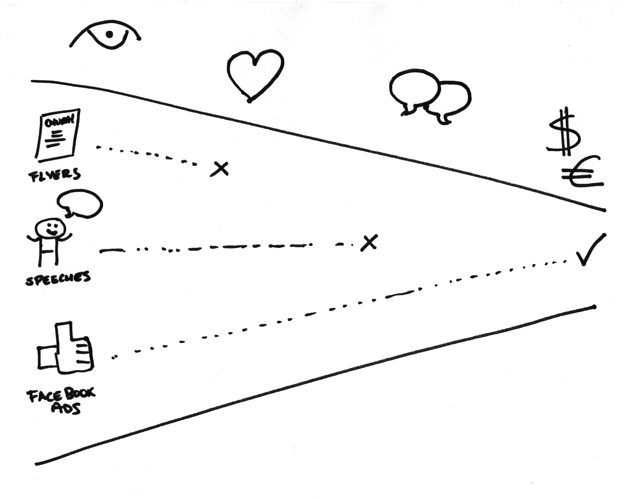The Marketing Funnel
“Social media was way cheaper. Posters didn’t work.”
-Samuel Njuguna
Most startups face this challenge in their early days, they need to market their product and build their customer base, but they don’t have many resources to do it. Chura faced this problem as they tried to build their business. Chura is a Kenyan company which allows users to buy and sell mobile data, money, and minutes, across mobile networks. In the early days, they were in a university dormitory and had time and determination, but very little money.
So what did they do? To begin, they came up with several hypotheses and tested them.
##A Strategy Starts with Ideas
“We tried putting posters in schools, giving talks in the university, dishing our fliers in public, and also to motorists. But it turns out, the city council wouldn’t allow giving out fliers without paying a fee… we got creative with the fliers - paid newspaper vendors to slip them in newspapers”
-Samuel Njuguna
Chura began by thinking about their different customer segments. They wanted to target students, working class professionals, and Kenyans who were more tech savvy. So they developed cheap marketing channels for each. But creating marketing channels starts with understanding the marketing funnel.
##What Is the Marketing Funnel?
The buyer funnel is a tool to help us understand the process of moving potential customers from people who have never heard of your business to customers. It allows us to think about how the different parts of our marketing fit together from the buyer’s perspective.
It begins with awareness, making customers aware of your business. Then you develop their trust. After that, you drive them into some form of direct communication, and finally to purchase. With each step, you lose some people, so improving your marketing becomes a matter of increasing awareness, or of improving the rate at which people flow from step to step.
Instead of thinking broadly about “how do I use marketing to acquire customers” Chura began by addressing the first step of the marketing funnel, awareness.
##Targeting the Awareness Stage
To target students and make them aware of Chura’s business, they handed out fliers on campus and gave talks at their university. For the working class professionals they woke up early and handed out fliers, for tech savvy Kenyans they created Facebook ads.
They ran into problems, but knew that’s how testing marketing ideas works. When the city council told them they had to pay a fee to hand out fliers, they began paying newspaper vendors to slip them into the morning papers that professionals read. Chura knew that even a limited budget could afford printing fliers, paying newspaper vendors, giving speeches, and paying for a few Facebook ads.
But critically, they started with several strategies and didn’t spend too much money on any of them until they knew what would work and what wouldn’t.
##Choosing Winning Idea(s)
“On the dishing out of the posters, we came to realize it wasn’t working very well. It was very hard for the student to single out a single poster and read it… what was working was giving talks in the universities and also trying a bit of online social media marketing with good conversion rates. For example the fliers, we were doing them in the morning, posters in the afternoon, social media in the evening”
-Samuel Njuguna
After trying out several of their ideas for a while, Chura collected as much information as they could to understand which ideas were working and which weren’t. We will discuss how Chura used data to determine this in a later lesson. But for now, just know that this wasn’t done based on just a feeling. So what did they learn?
First, posters and fliers really just didn’t work. Their customers didn’t seem to have time to read them. But while that seemed clear just from watching people take them, what really told them which strategy was working was asking their customers how they found out about Chura. That told them that Facebook ads were the answer.
Plus, those Facebook ads allowed them to see who ultimately used their service and then go back to see which marketing channel got them there. This gave Chura more information they could use to improve their marketing strategy.
“We went ahead and started asking customers how they learned about us, the majority said they saw a Facebook ad. It’s a no brainer, that’s where our marketing was working so that’s where we focused.”
-Samuel Njuguna
##Using Limited Resources
Ultimately, Chura learned that while there is marketing you can do for free, like giving speeches at their university, tactics that got many potential customers into the awareness stage. there was still plenty they could do for very little money. That meant paying for fliers and posters as well as putting a few dollars a day into Facebook ads.
Once they could figure out which channel worked based on data, they could feel confident in putting more of their limited resources into that channel. For them it was Facebook ads, but for your business it could be promoters, fliers, customer exchange programs, or any number of other channels.
##Thinking About the Marketing Funnel
Additionally, those Facebook ads had the flexibility to change when Chura needed to move potential customers down the marketing funnel. So while fliers were really only suited for the awareness stage, Facebook ads could work for every step. This was another critical decision in thinking about which channels to use.
Now, Chura has over 3,000 users every month and around 70% repeat users. That means their marketing channels are bringing the right kind of users to them. Getting there didn’t necessarily take a lot of money, it took trying a variety of ideas and finding out what worked.



